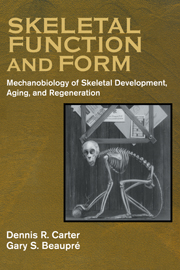Book contents
- Frontmatter
- Contents
- Preface
- Chapter 1 Form and Function
- Chapter 2 Skeletal Tissue Histomorphology and Mechanics
- Chapter 3 Cartilage Differentiation and Growth
- Chapter 4 Perichondral and Periosteal Ossification
- Chapter 5 Endochondral Growth and Ossification
- Chapter 6 Cancellous Bone
- Chapter 7 Skeletal Tissue Regeneration
- Chapter 8 Articular Cartilage Development and Destruction
- Chapter 9 Mechanobiology in Skeletal Evolution
- Chapter 10 The Physical Nature of Living Things
- Appendix A Material Characteristics
- Appendix B Structural Characteristics
- Appendix C Failure Characteristics
- Index
Appendix B - Structural Characteristics
Published online by Cambridge University Press: 11 January 2010
- Frontmatter
- Contents
- Preface
- Chapter 1 Form and Function
- Chapter 2 Skeletal Tissue Histomorphology and Mechanics
- Chapter 3 Cartilage Differentiation and Growth
- Chapter 4 Perichondral and Periosteal Ossification
- Chapter 5 Endochondral Growth and Ossification
- Chapter 6 Cancellous Bone
- Chapter 7 Skeletal Tissue Regeneration
- Chapter 8 Articular Cartilage Development and Destruction
- Chapter 9 Mechanobiology in Skeletal Evolution
- Chapter 10 The Physical Nature of Living Things
- Appendix A Material Characteristics
- Appendix B Structural Characteristics
- Appendix C Failure Characteristics
- Index
Summary
Strength of Materials Approach
The continuum material concepts of stress, strain, and material properties are critical to understanding the mechanical response of a structure to applied loads. In this section, we present a few examples of stress analyses of long bones subjected to axial, bending, and torsional loading. We use a method that is sometimes referred to as a strength of materials approach. This approach yields accurate estimates of deformations and stress and strain distributions for structures with simple shapes, material property distributions, and loading conditions. The solutions can also provide approximations of the mechanical response of slightly more complicated problems in structural mechanics.
First consider a long bone that is being compressed by forces (F) applied to both ends (Figure B.1). We assume here that the diaphysis of the bone is straight and that the force is directed through the centroid of the cross section of the mid-diaphysis. We further assume that the diaphysis is perfectly cylindrical with an endosteal inner radius of ri and periosteal outer radius ro. Let us now consider the distribution of stress on a transverse plane through the midshaft. Conceptionally, we can isolate a short section of the diaphysis of length L (Figure B.1). Since this region is far from the areas of force application, the axially oriented internal force will be spread over the entire section and the normal stress σzz at all points in the plane will be equal to F/A where A is the cross-sectional area of the mid-diaphysis. There will be no shear stress acting at the section (σzx = σzy = 0).
- Type
- Chapter
- Information
- Skeletal Function and FormMechanobiology of Skeletal Development, Aging, and Regeneration, pp. 283 - 291Publisher: Cambridge University PressPrint publication year: 2000



